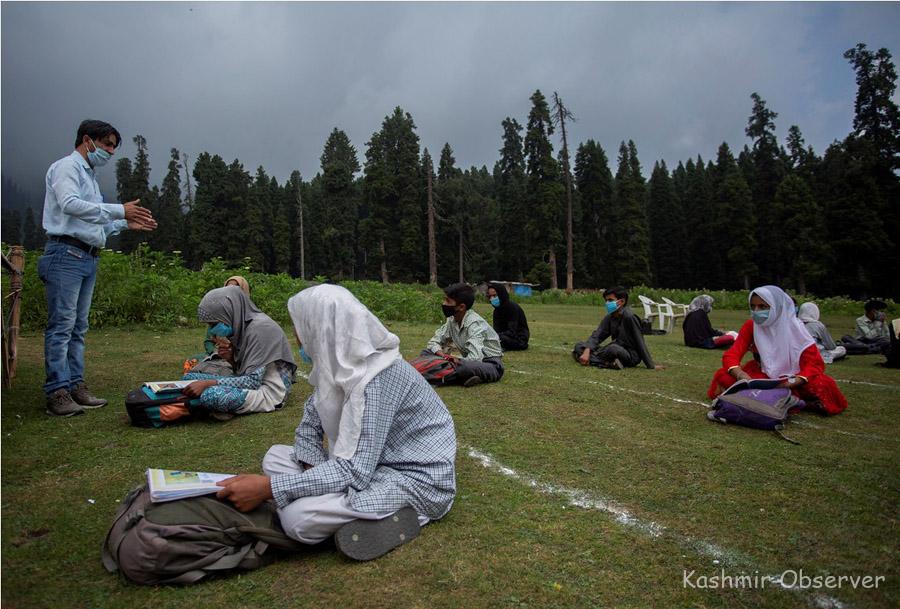
By Ummar Jamal
Societal and business transformations unfold with significant impact when unforeseen circumstances prompt widespread exploration of innovative concepts. A prime example is seen during World War II, where the absence of American men led to women showcasing their competence in traditionally male roles, demonstrating their capability with excellence. In the same way, the Coronavirus pandemic forced global experimentation with remote teaching, thereby making us realise that online learning is the future of education.
In recent years the landscape of conventional education has undergone a significant transformation. The confines of a traditional classroom are no longer the sole avenue for learning. With the advent of the internet and cutting-edge technologies, education has transcended physical boundaries. Today, the opportunity for a high-quality education presents itself anywhere and anytime, as long as one has internet access. We find ourselves on the brink of a new epoch – the evolution of online learning.
The conventional model of brick-and-mortar universities faces a challenge from the emergence of virtual institutions. These virtual institutions have become more than just an alternative; they have become a necessity. In a country as diverse and populous as India, the need for virtual universities is paramount.
Recent Developments
In January 2021, the Indian government unveiled plans to establish a virtual university with the aim of integrating technology into education. The subsequent Budget for 2021-22 was expected to prioritize this initiative. During a high-level stakeholder meeting in January 2021, Ramesh Pokhriyal Nishank, the Union Minister of Education, emphasized the government’s intent to create Virtual Universities, distinct from open universities, to bolster higher education as envisioned in the National Education Policy (NEP).
The Union Budget of India on February 1, 2022, announced the establishment of the nation’s first centrally operated digital university. This pioneering move seeks to enhance global access to high-quality higher education. The budget also outlined plans to elevate virtual labs and top-tier electronic learning resources. This strategic decision follows the introduction of two state-run digital universities in India: the Kerala University of Digital Sciences, Innovation and Technology established in January 2020, and the subsequent announcement of a digital university in Jodhpur, Rajasthan, in February 2021.
Why Virtual Universities
An imperative driving the establishment of virtual universities in India is the drive to enhance accessibility and inclusivity. The vast geographical expanse of the country often poses obstacles for students in remote or rural areas to access quality higher education. Virtual universities can bridge this gap by providing an online platform that eliminates the need for physical relocation, making education accessible to all, regardless of their geographic location.
India currently has 35 million students enrolled in higher education, resulting in a gross enrolment ratio (GER) of 26 percent. Comparatively, China, with a larger population, boasts a significantly higher GER of 51.6 percent. To achieve the goal of a 50 percent GER by 2035, as stipulated in the NEP 2020, prioritizing online learning is paramount. The NEP’s provisions for flexible entry-exit points and credit banks will be optimally realized in an online setting. It will pave the way for the digitisation of higher education enshrined in the National Education Policy of India 2020.
Virtual university in Jammu and Kashmir
One of the primary objectives of virtual universities is the universalization of education, and in a state where the literacy rate is as low as 67.16% according to the 2011 census, the establishment of a full-fledged virtual university akin to the successful model in Kerala, where various professional and non-professional courses are offered, could prove instrumental in elevating educational standards. The introduction of a virtual university in Jammu and Kashmir has potential to bring in a new era of educational accessibility, addressing longstanding challenges and unlocking a myriad of benefits for the region.
A significant issue that has plagued Jammu and Kashmir is the migration of students to other states in pursuit of higher education opportunities. The departure of Kashmiri students not only deprives the state of its intellectual capital but also inflicts a substantial economic toll. Astonishingly, around Rs 1500 crore drains from the Valley each year due to this migration, exacerbating the region’s financial challenges and impeding sustainable development
The nationwide lockdown in response to the Covid-19 pandemic further underscored the challenges faced by Kashmiri students studying outside the state. The J&K government reported over 10,000 stranded students in different states during the lockdown, highlighting the urgency of bridging the educational gap within the region. The actual number of affected students could be even higher, considering that many had returned to the Valley before the imposition of the lockdown.
The advent of a virtual university in Jammu and Kashmir holds the potential to reverse this trend by offering quality higher education opportunities within the state. This not only addresses the economic drain caused by student migration but also ensures that educational pursuits are not hampered by external crises, such as the Covid-19 pandemic. By providing a platform for remote learning, a virtual university becomes a powerful tool for the empowerment of the local population, contributing to the overall development and prosperity of Jammu and Kashmir.
Advantages of Virtual University
Virtual universities offer unparalleled flexibility in terms of learning schedules and formats, catering to diverse demographics such as working professionals, homemakers, and individuals with various commitments. By enabling students to access lectures and study materials at their own pace, virtual universities facilitate a harmonious integration of education with other responsibilities, nurturing a culture of lifelong learning.
Conventional universities entail substantial costs, encompassing tuition fees, accommodation, and commuting expenses. Virtual universities can substantially alleviate these financial burdens by eliminating the need for physical infrastructure and associated costs. This economic advantage enables students to receive quality education while enjoying the comfort of their own homes.
Collaboration with experts and professionals worldwide is a hallmark of virtual universities, offering a diverse range of courses that may not be available in traditional institutions. This diversification caters to niche interests and emerging fields, empowering students to explore passions and cultivate specialized skills.
Integrating technology into education enhances the learning experience. Virtual universities employ innovative tools like virtual reality, simulations, and interactive platforms to render complex concepts comprehensible and engaging. This approach stimulates critical thinking and creativity among students.
Virtual universities possess the potential to foster a global learning environment by connecting students with peers and educators from different countries. This exposure encourages cross-cultural collaboration, idea exchange, and a comprehensive perspective on various issues, equipping students to thrive in an interconnected world.
Conventional universities often grapple with resource constraints and overcrowding. Virtual universities can scale more efficiently, accommodating a larger student body without undue strain on resources. This scalability aligns with the surging demand for higher education in a densely populated nation like India.
The establishment of virtual universities dovetails with efforts towards environmental conservation. Reduced commuting and decreased reliance on physical infrastructure contribute to a smaller carbon footprint, rendering education more sustainable.
Tailpiece
As the nation progresses towards a digital future, embracing virtual education stands as a key to unlocking the full potential of its citizens and propelling India onto the global stage as a knowledge powerhouse. The potential benefits, encompassing cost-effectiveness, diverse course offerings, and global networking, present a compelling rationale for the integration of virtual universities into India’s educational landscape.
In the digital age, possessing digital literacy and proficiency is imperative. Establishing more and more virtual universities will enable India to equip its citizens for the demands of the 21st-century job market. Graduates with experience in online learning are better poised to leverage technology in their careers and adapt to remote work scenarios.
Views expressed in the article are the author’s own and do not necessarily represent the editorial stance of Kashmir Observer
- The author is Kashmir based columnist. He tweets at ummar_jamal and can be reached at [email protected]
Follow this link to join our WhatsApp group: Join Now
Be Part of Quality Journalism |
Quality journalism takes a lot of time, money and hard work to produce and despite all the hardships we still do it. Our reporters and editors are working overtime in Kashmir and beyond to cover what you care about, break big stories, and expose injustices that can change lives. Today more people are reading Kashmir Observer than ever, but only a handful are paying while advertising revenues are falling fast. |
| ACT NOW |
| MONTHLY | Rs 100 | |
| YEARLY | Rs 1000 | |
| LIFETIME | Rs 10000 | |













